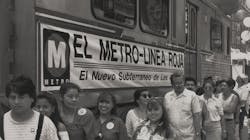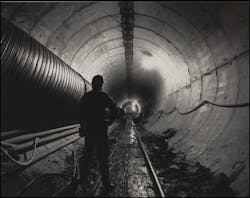L.A. Metro celebrates 30th anniversary of Red Line
The Los Angeles County Metropolitan Transportation Authority (L.A. Metro) celebrated the 30th anniversary of the B (Red) Line. On an average weekday, L.A. Metro says the B Line has about 75,000 boardings. Together with the D (Purple) Line, which shares some of the same track, the B Line has seen more than 400 million boardings over the past decade.
Before the first 4.4-mile segment of the Red Line debuted in 1993 between Union Station and MacArthur Park, the idea of underground rail in Los Angeles concerned the public. There had never been a modern subway in Los Angeles before.
The leaders of L.A. Metro’s predecessors, the Southern California Rapid Transit District (SCRTD) and the Los Angeles County Transportation Commission were determined to assuage the public’s concerns. They put out informational videos, demonstrating how the new system would work for millions of would-be riders. Safety from natural disasters was a top priority, and the engineers had planned for everything, including seismically-reinforced tunnels, fire-resistant vehicles and emergency sprinklers.
To drum up excitement for the new subway, SCRTD initiated a public art element. Officials dedicated .05 percent of the capital project budget for public artworks in each station. This was considered a huge sum at the time. Each station was envisioned as an underground gallery that channeled a unique sense of place (such as Stephen Antonakos’ 12 neon sculptures that paid homage to the first neon-illuminated building in Pershing Square, or Roberto Gil de Montes’s allegorical triptych describing the descent underground at the 7th St./L.A. Metro Center Station). Art was also regarded as a social salve that could discourage litter and vandalism.
It took 6.5 years to complete the first segment of the Red Line, which cost $330 million per mile, but for many Angelenos, it was worth the wait. More than 52,800 people rode on the first day. Over 91,000 people rode it on the second day. By April 1, 1993, the Red Line had welcomed its millionth passenger.
“For now, the novelty of the Red Line seems to have created a jovial atmosphere,” the Los Angeles Times reported in February 1993, nearly a month after the Red Line opened. “Unlike the New York City subway, where people were accustomed to avoiding eye contact, Angeleno riders are still intrigued enough by their new surroundings they have yet to develop the surly exterior of commuters whose only concern is to get quickly from here to there.”
When the Red Line debuted, keeping the sleek Italian-made subway cars clean and pristine was all-important. If riders didn’t feel comfortable descending into the stations, LA’s bet on rail would be worthless. Therefore, L.A. Metro invested in an ambitious cleaning campaign, preparing for the worst. Despite their concerns, however, there was little to clean, especially during those first months.
Thirty years later, the Red Line is now officially known as the B Line and continues beyond MacArthur Park. By 2000, it had been extended all the way to North Hollywood. There have been new challenges, including the COVID-19 pandemic and the increase in L.A. Metro’s region’s unhoused population.
The Red Line introduced a new mode of transportation to a city designed for driving. It was proof of concept that local rail can work in Los Angeles, in spite of claims that it couldn’t be done. It was a critical step toward the brighter, fairer and cleaner future.


